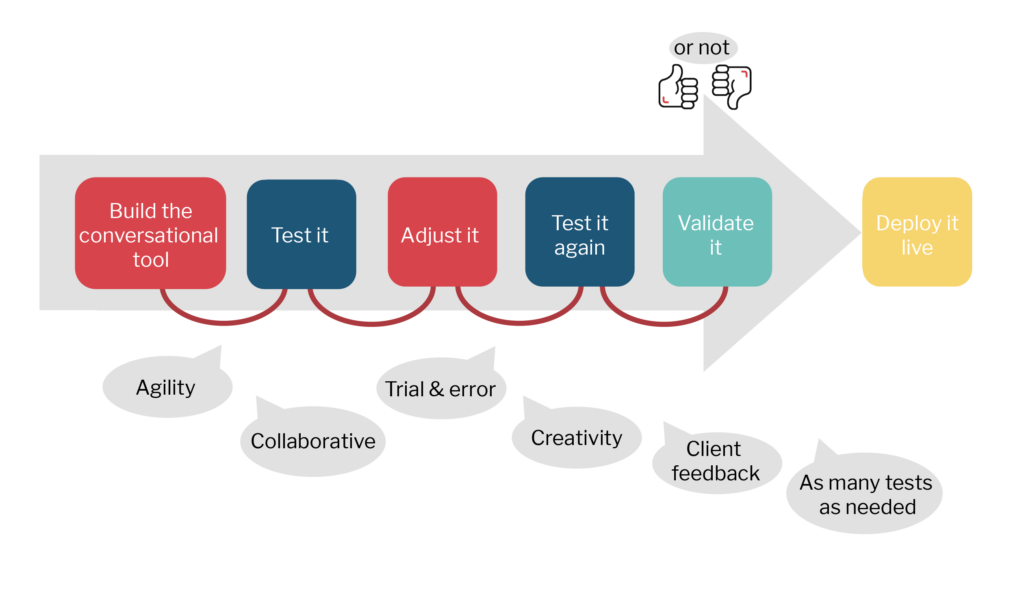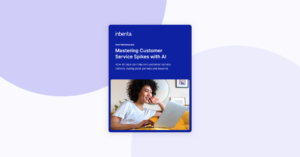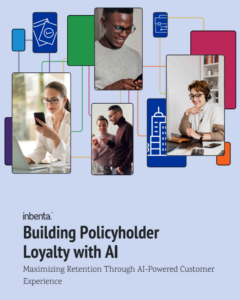Before starting to work on a chatbot project, it is necessary to ask yourself three key questions about this solution: Why, How and What? These three questions should underlie any project launch, namely the nature of the project itself, its final objective and its fulfillment. Here are the three keys that will allow you to properly initiate a chatbot project.
Define the stakes and set clear objectives for your AI Chatbot Project
My company would like to set up an AI chatbot. Sure, but what are the objectives? There may be several internal needs that meet several objectives and they must be well defined beforehand.
For example:
- Improve user experience:
- By adding a new self-service tool
- Available 24/7
- Make it easier to navigate and search for information on the desktop site
- Better manage contact flows:
- Reduce the number of calls with low added-value
- Reduce the flow of incoming emails from the desktop site
- Increase the customers’ autonomy on the desktop site on:
- Quotation requests
- Retrieval of personal information/documents
- Increase conversion rate
- Improve customer knowledge
Each of these objectives has to be measurable both qualitatively and quantitatively. It is, therefore, necessary to think carefully about the metrics to monitor to ensure that once in production, the solution in place meets these KPIs and to see how it can be improved if necessary.
For example: reducing the volume of incoming emails by 20 to 30%, top 5 themes handled by the bot, number of quotes generated thanks to the chatbot.
Structure your AI chatbot team and assign them missions
A project team has to be created from the client and the provider’s end in order to manage the chatbot project. It requires on each side at least a Project Manager or Product Owner, Editorial Managers (Botmaster and Chatbot Author) and a Developer. If your chatbot project is part of a more global self-service experiment, it is probably necessary to involve customer journey experts, analytics experts, ergonomists, business experts, legal experts, etc.
It is then necessary to define how the different parties involved should work together. This can be, for example:
- Setting up a common management tool;
- A common messaging tool;
- Creating a common messaging address for the entire project team;
- Setting up daily meetings;
- Organizing weekly meetings between the project team; and,
- Regular reporting to the steering committee.
More generally, each team member must have a specific mission, whether it is regarding the preparation, the implementation or the follow-up and monitoring stages. Indeed, the main stages when setting up a chatbot project are as follows:
- Drafting a requirements specification;
- Definition customer journeys;
- Drafting an editorial charter;
- Writing chatbot contents and organizing them as a dialogue hierarchy;
- Drafting a graphic charter;
- Defining KPIs to monitor;
- Elaborating user test scenarios and analyzing their results;
- Technical integration of the chatbot on the test environment; and,
- Internal and external communication on the project.
For every stage of the project, a methodology must be established and followed by all team members.
For example, when setting up a process for the testing phase, you need to think about the tools to be used to carry out the tests, the frequency of the testing phase, its duration, etc. A testing phase usually consists of 2 batches (1 batch of patches, then a customer verification batch), the duration of each batch usually lasts for 1 week and there are usually 3 testing batches in total.
AI Chatbot Project : Experiment the “Test and Learn” mode
It’s difficult to work on such an innovative solution as an AI chatbot using a classic project mode, in a V cycle. You surely want to deploy a quality chatbot quickly, so you need to be as agile as possible. The best way to do so is to work in iteration: deployment of a first version then testing and adjustment, deployment of a second version then testing and adjustment, etc, until you reach a product that you’re satisfied with. The important thing is to have your initial objectives in mind in order to develop the project in the most intelligent way.

For example: you originally wanted your chatbot to answer questions and be polite and it is, but you realize that it is unable to tell a joke. You then quickly add some jokes during the adjustment phase. But is it really relevant? Was that your original goal? What will be the added value for the end-user?
If it is relevant, then it indicates that your initial objectives were not well enough thought out and defined. If it is not relevant, then you should immediately refocus on your initial purpose, as this is what should guide you and help you stay on track. Indeed, the difficulty when using the agile method lies in the fact that you are going to want to test everything, leading you to lose sight of your initial goal.









